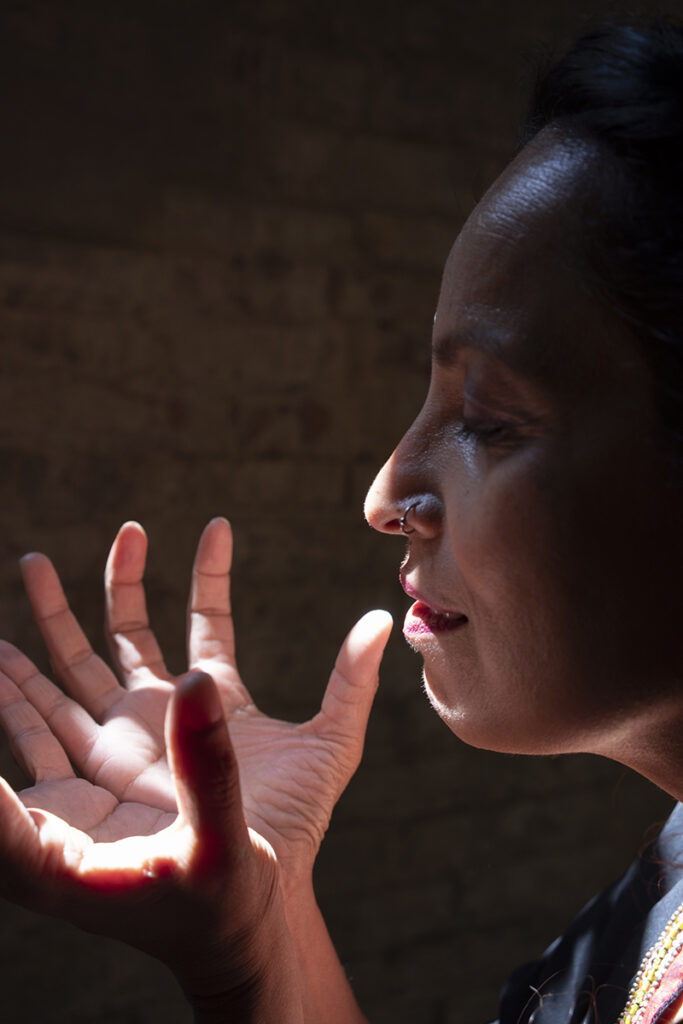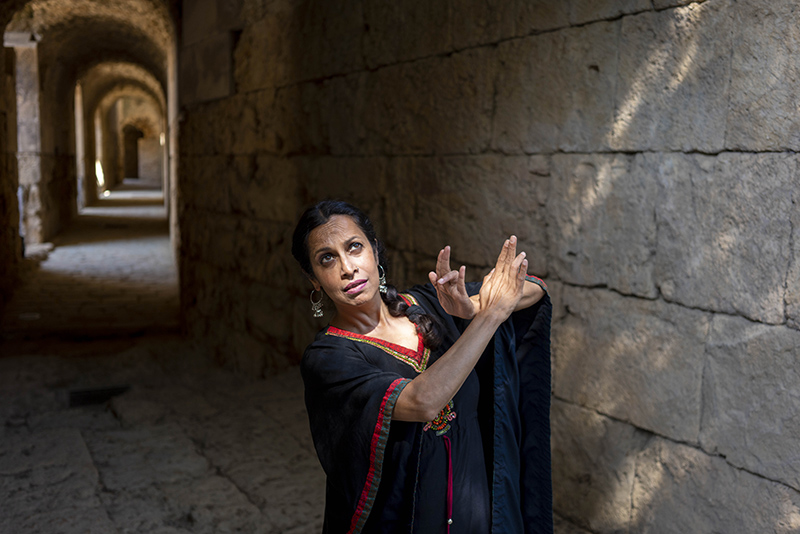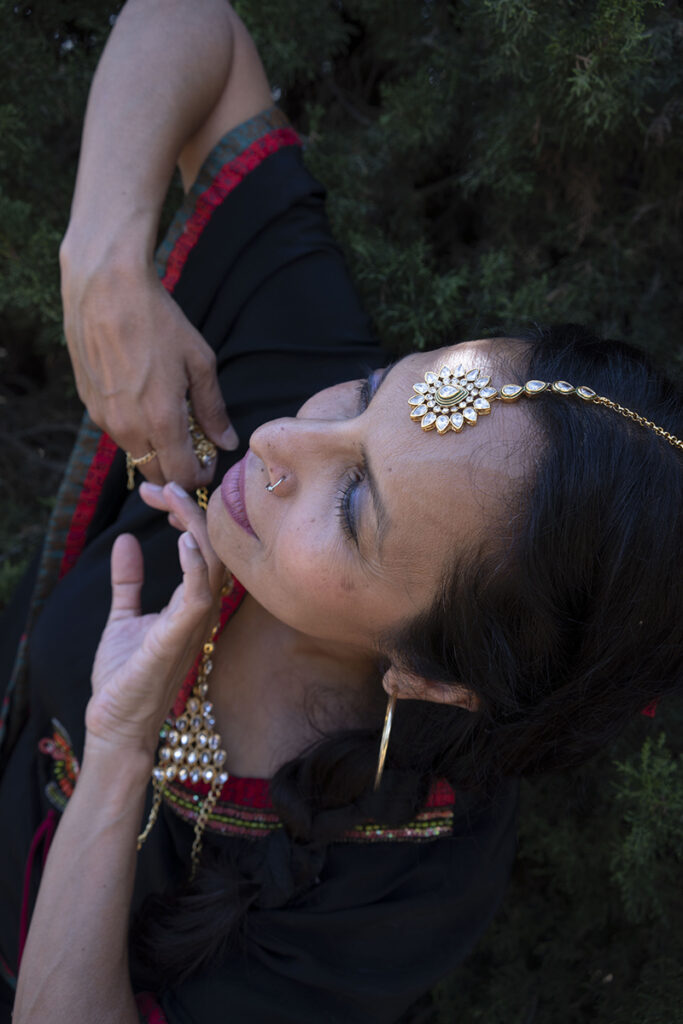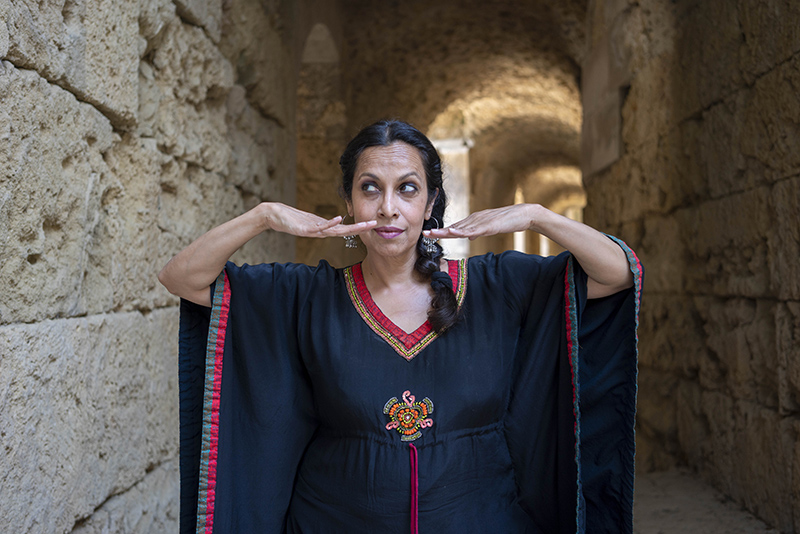Of Stones and Dance
BY SHEBANA COELHO
Photos by Hu Rong of Shebana Coelho in the ruins of the ancient city of Italica, near Seville, Spain.
Note: This essay was first published in Stance on Dance’s fall/winter 2023 print issue. To learn more, visit stanceondance.com/print-publication.
My first memory of dance was a memory of dread.
A child had to go somewhere in Bombay to give an exam. Someone drove her. It was in town, far enough away from the suburb where we lived that we had to arrange for the driver to come early. I remember, for once, my mother and I left our bungalow at the appointed time. Meaning we were not late to leave as we usually were.
The exam was a choreography. In the room she entered, there were a few adults watching – a committee of some kind. One of them was a woman with glasses. There must have been a teacher too, the one who taught the girl.
The girl was eight or nine or ten. She danced the exam. She made mistakes. But she passed – barely.
Her stomach was full of rocks.
That morning, she had woken up with them. She had cradled them all night.
Even the sun was a stone and it had landed on her.
She was dressed in finery that I now would savor, the ritual of preparing for love.
She wore bells on her feet and flowers in her hair.
Like dreams drenched in a lake, I see all the dance lessons before that moment. They took place in a room with large grey tiles. The floor was cold and smooth. There must have been a teacher speaking and singing. There must have been the sound of taal, the beat of all ages and the bending of hands and feet to it.
It was a private class. The teacher knit her brow as she taught. She snapped her voice. She shook her head. She urged the girl to show some grace.
At first, the girl had no feel for the dance. Everything was stone.
But later, there were small moments – I remember them as blips – when the steps matched sound and she fell into a rhythm.
But then everything went dark. For decades, there was silence, stasis.
Then in my 30s, I fell in love, first with salsa, then with flamenco, then with the bharatanatyam I had learned as a child.
And now the girl is awakening in me. Or I am awakening in the memory of her?

Now, the stones are singing.
Fui piedra y perdí mi centro.
Once I was a stone and I lost my
center.
That’s the start of an old flamenco letra, a verse sung por soléa, a flamenco style that means solitude.
Now the sun is a dancer and she moves across the sky. I hear the music she makes with her feet.
Now I am the music, the feet, the memory, the sun. Also the sky. Also, the sea reflecting the sky.
The flamenco verse continues:
Fui piedra y perdí mi centro.
Y me arrojaron al mar.
Once I was a stone and I lost my center.
And they threw me into the sea.
I couldn’t get enough of this verse. I kept listening to versions sung by Enrique Morente and La Niña de los Peines, both famous flamenco singers.
Then a few years ago, I went and asked my mother to attempt an Urdu version of it. I had begun performing solo plays, and I sensed I wanted this new play to begin with that same stone in Urdu.

Why Urdu? Why now?
I couldn’t answer that easily. Except to say that Urdu is also calling to me now like a lost root.
Urdu came to India with the Mughals or rather, because of them. Somehow Hindi, Persian, Arabic, and other languages mixed together and produced a language that has become known for poetry, especially about love and belonging. Urdu is associated with Muslims, and in India these days, it might even be called a dangerous sound because speaking it might endanger your life.
But in the India in which my mother lived till she was 40 and I lived till I was 12, Urdu was the language of lavish lyric Bollywood films. Some were period pieces about princes and courtesans. Urdu also has famous verses, shayaris and ghazals, by long-ago poets like Iqbal and Mirza Ghalib. If you speak these verses in casual conversation, someone might respond with a wah wah. A wow. They might even make a gesture called adaab, where you slightly bow your head, and brandish your hand, palm cupped, facing up – as if you were cradling the lyric in your hand and gently shaking it, inhaling the beauty of it.
My mother’s name is Tanveer. It means “the first rays of dawn”. As a teenager, she and her cousin had gone out of their way to find Urdu, taking poetry classes with a woman who lived beyond Linking Road, near National College.
I had grown up on the margins of the language, always longing for it without knowing why. In our household, we spoke English. For years, even as I longed for Urdu, I kept my distance from it. I feel that longing and that distance is connected to the colonization of India by the British and my coming from a class created to be English in intellect, as Lord Macaulay famously put it in his 1835 treatise, Minute on Education. This treatise became the education policy of colonized India. The whole quote bears repeating:
We have to educate a people who cannot at present be educated by means of their mother-tongue. We must teach them some foreign language…We must at present do our best to form a class who may be interpreters between us and the millions whom we govern–a class of persons Indian in blood and colour, but English in tastes, in opinions, in morals and in intellect…
My journey of awakening to the created class in my heritage is another story. But it is also part of this one.
Once I was a stone and I lost my center.
And they threw me into the sea.
And after a long time, my center returned to me.
That’s the full Spanish letra. I’ve heard it attributed to the nineteenth century cantaora, La Serneta, famous for her verses and for living her love boldly.
My new play was going to be about love and loss and I had a strong feeling I wanted to speak some of its story in the stone verse, in Urdu.

But in the first few conversations with my mother, it didn’t seem like it was going to work. And then suddenly one morning, my mother called me and said, “I have it.”
She spoke her translation. The Urdu version was longer than the original. In fact, it was its own story.
It starts the same:
Mei ek bar pathar thi, magar apne aap ko kho gayee.
Once I was a stone, and then I lost myself.
Then, in her version, there is nikama, being useless:
Nikama samajkar kisee ne muhje samunder me phek diya.
Thinking I was useless, someone threw me into the sea.
Years decades eons pass.
Arsei guzrei, vahi rahin
Nacheez bandé ko waqt ka kya kehna
For useless people, what use is time?
Then hope surges from the very waves in which the dance is drowning:
Jinhi mujhoo me dubee thee, unhee mujho né rah dikhaya
In those same waves in which I was drowning,
Those waves showed me the way out.
“And then,” my mother said, “here comes the last line and after it, you have to make some ta pa ta ta sounds with your feet.”
“Got it,” I said.
“Mei apne aap ko paa gayee,” she said.
“I found myself again.”
ta pa ta ta.
And aisa, así, like this, decades after that first memory of dread, my feet danced a new story.

~~
Shebana Coelho is a writer and a performer, originally from India, once based in New Mexico, and now in Spain.
